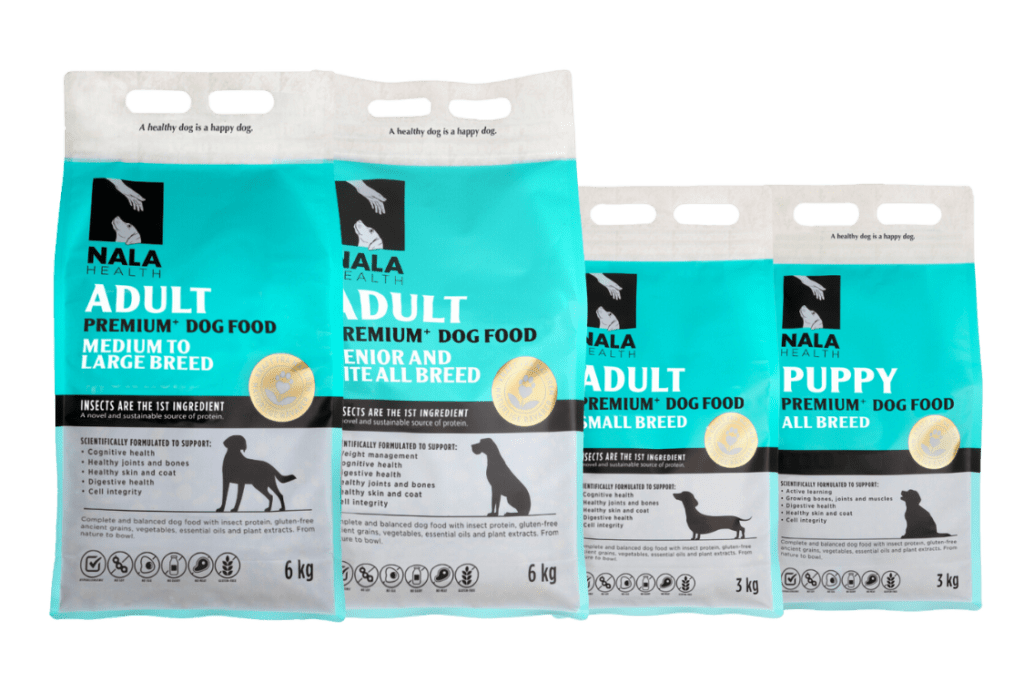Exploring Novel Protein for Dogs
 Cecilie Hemsen Berg
Cecilie Hemsen Berg
If your dog has been diagnosed with a food allergy or sensitivity, you have probably come across the term “novel protein”. Novel proteins are unique protein sources that your dog likely hasn’t encountered before. By introducing these alternative proteins, you can help reduce adverse reactions and improve your dog’s overall well-being. In this blog we delve into the prevalence of food allergies, sensitivities and intolerance in dogs, the main culprits behind these issues, and the concept of novel proteins as a potential solution. Join us as we explore the world of novel proteins and discover how they can be a game-changer for dogs with food allergies, sensitivities and intolerances.
Prevalence of Food Allergies, Sensitivities and Intolerance in Dogs
Food allergies, sensitivities, and intolerances are different types of adverse reactions to food, though often confused with each other. These issues are common concerns for dog owners when their pets suffer from itching, hives, and gastrointestinal issues. Understanding these conditions and their causes is crucial for your dog’s health. Since these symptoms can have various origins, a veterinarian can provide an accurate diagnosis. Let’s take a closer look at each:

Food Allergies
Most dogs with true food allergies are actually allergic to a specific protein rather than a grain, as many assume. Food allergies (also known as cutaneous adverse food reaction, CAFR) involve the immune system, and studies suggest that about 1-2% of dogs are suffering from food allergies.When a dog has a food allergy, its immune system mistakenly identifies a particular protein in the food as harmful and mounts an immune response against it. Think of it like a false alarm in a security system. Normally, the security system (the immune system) protects the house (the dog’s body) by responding to actual threats. But in the case of food allergies, the system mistakenly identifies a harmless protein as a burglar and sounds the alarm.
When this happens, the dog’s immune system releases immunoglobulin (IgE) antibodies, triggering the release of inflammatory substances (histamine and other chemicals), causing various symptoms like:
- Skin issues: intense itching, redness, hives – especially paws, face, ears, belly and under the tail. Secondary infections with bacteria and yeast are also very common in these areas and can worsen the itch from allergies.
- Gastrointestinal problems: vomiting, diarrhoea, and gas.
- Respiratory issues: sneezing, coughing.
- In severe cases, food allergies can cause difficulty breathing, and in worst cases – anaphylactic shock, which is life-threatening.
Food allergies can develop at any age, and dogs can become allergic to foods they have been eating for years without any issues. Diagnosing food allergies typically involves elimination diets and food trials, where suspected allergens are removed and then reintroduced to observe any adverse reactions.
In addition to protein, other factors that can contribute to food allergies include bacteria, mould or storage mite in the food. If you store the dry food in larger containers, these must be cleaned regularly and kept in a dark, dry and cool environment.

Food Sensitivities or Food intolerance
Food sensitivities, also known as food intolerance, refer to a broad range of adverse reactions to food that may or may not involve the immune system. Instead, it is usually a result of an inability to digest certain ingredients properly. These reactions can be responses to certain ingredients or additives in foods, or naturally occurring chemicals in foods. Food sensitivities affect about 10-15% of dogs and can cause various symptoms, including:
- Gastrointestinal issues like vomiting, bloating, gas and diarrhoea
- Skin problems like itching and rashes
- Joint pain
- Behavioural changes like irritability
- Fatigue
Furthermore, some sensitivities are caused by a deficiency of certain digestive enzymes. Common culprits are lactose (found in dairy) and gluten (found in grains like wheat, rye, barley). Symptoms are primarily gastrointestinal, such as bloating, gas, diarrhoea and reflux. Another cause can be histamine intolerance (HIT) or enteral histaminosis. The gut plays a crucial role in managing histamine levels, primarily due to the activity of the DAO enzyme in the intestines. When functioning properly, this enzyme breaks down histamine, preventing it from entering the bloodstream. However, poor gut health and conditions such as IBD (inflammatory bowel syndrome) can impair the effectiveness of the DAO enzyme.
Factors that can increase histamine in the body: infections, stress, inflammation, trauma, high activity/exercise, B12 or B9 deficiency, and magnesium deficiency in addition to food high in histamine. An imbalance in gut bacteria, commonly known as dysbiosis, can also contribute to elevated histamine levels.
Food sensitivity/intolerances are not life-threatening but can make your dog feel uncomfortable and unwell. Diagnosing food sensitivities also involves elimination diets, but may require more detailed analysis to identify specific intolerances, such as lactose or gluten intolerance or sensitivity to specific additives.
Understanding these differences is crucial for managing and treating dietary issues in dogs, as the approach to handling food allergies versus sensitivities can differ significantly. If a dog is suspected of having a food allergy or sensitivity, it is essential to consult with a veterinarian for accurate diagnosis and appropriate management.

The Role of Novel Protein in Diagnosis
Novel proteins play a crucial role in diagnosing food allergies, sensitivities, and intolerances in dogs. Since these proteins are new to your dog’s diet, they minimise the risk of triggering an adverse reaction during the diagnostic process. Here’s how novel proteins are used:
- Elimination Diet: When a dog shows symptoms of food allergies, sensitivities, or intolerances, a veterinarian may recommend an elimination diet that includes a novel protein. Some also recommend diets containing hydrolyzed proteins that have been broken down to make them less likely to cause an allergic reaction. Since the dog hasn’t been exposed to this protein before, it’s less likely to cause an adverse reaction, helping to clear existing symptoms.

- Clear Baseline: By feeding your dog a diet with novel proteins, you establish a clear baseline of what a non-reactive state looks like. This makes it easier to identify any changes when other foods are reintroduced.
- Reintroduction Phase: After a period on the elimination diet, suspected allergens or intolerances are reintroduced one at a time. If symptoms reappear, it indicates a reaction to the reintroduced food. Because the baseline was established with a novel protein, any new reactions can be more confidently attributed to the reintroduced foods.
- Accurate Identification: Using novel proteins helps in accurately identifying not just allergies, but also sensitivities and intolerances. By starting with a novel protein, veterinarians can distinguish between immune-mediated reactions (allergies) and non-immune responses (sensitivities and intolerances).
Using novel proteins ensures a precise and effective diagnosis, allowing for better management of your dog’s dietary issues and overall health. This approach ultimately leads to a more accurate identification of specific food-related problems and helps in crafting a suitable diet plan that keeps your dog healthy and comfortable.
When it comes to food intolerances, diagnosis is also based on the dog’s history, symptoms, and response to dietary changes.
Common Ingredients Causing Allergies, Sensitivities and Intolerance
Several common ingredients in dog food are known to cause allergic reactions, sensitivities and intolerance. The most frequent offenders include:


- Beef (34%): One of the most common allergens in dog food. Beef is often the primary protein source, making it a frequent culprit.
- Dairy (17%): Lactose intolerance and allergies to dairy products can cause gastrointestinal distress and skin issues.
- Chicken (15%): Another common protein source, chicken, is often associated with allergic reactions in dogs.
- Gluten (13%): Gluten in wheat can cause intolerance, leading to digestive and skin problems.
- Eggs (4%): Egg proteins can also trigger allergic reactions in some dogs.
- Soy (6%): Soy products can lead to sensitivities and allergies in certain dogs, causing a range of symptoms from digestive upset to skin issues.
- Less common allergens: include corn, pork, fish and rice.
- Other potential indicators include animal by-products*, sugar, artificial additives, harmful preservatives, overuse of antibiotics, and environmental chemicals. These factors can alter gut microorganisms, negatively impacting the immune system.*(including skin, bones, lungs, spleen, kidneys, brain, liver, blood, fatty tissue, stomach and intestine freed of their contents)
Novel Proteins: A Solution for Sensitive or Allergic Dogs
For dogs with food allergies or sensitivities, novel proteins can be a good hypoallergenic option. Novel proteins are those that the dog has not been exposed to previously, reducing the likelihood of an allergic reaction.
Choosing a diet with an appropriate novel protein might also be a matter of trial and error, as different diets and protein sources may be suitable for different dogs. It is of key importance that the elimination diet provides transparency in regards of ingredients. Although pet food labels must be detailed and should inform about ingredients, mislabeling is a growing problem in the pet food industry.
Novel Proteins in Dog Food
Novel proteins provide an alternative to traditional protein sources like beef, chicken, and lamb aiming at catering to dogs with sensitivities and allergies.
- Duck: A lean, easily digestible protein, especially high in iron.
- Ostrich: A lean, easily digestible protein that is rich in nutrients such as iron, zinc, and vitamin B12. This red meat is more sustainable than traditional red meat.
- Venison: Venison is usually red meat and the general term for deer meat. It contains high amounts of vit B, and is a lean source of protein.
- Rabbit: Rabbit meat is another hypoallergenic option that can be beneficial for dogs with food allergies.
- Fish: Fish are less likely to cause allergic reactions and offer omega-3 fatty acids, which are beneficial for skin health, decrease the inflammation typically associated with the likes of arthritis as well as benefit the immune system. Herrings, mackerel and cod are also an excellent source of easily digestible protein rich in omega-3 fatty acids.
- Black Soldier Fly Larvae: Easy digestible, complete protein rich in calcium, zinc, iron, and medium-chain triglyceride (MCT). This is also among the sustainable sources of protein.
- Krill. Rich in omega-3 fatty acids, particularly EPA and DHA, which are beneficial for skin health and reducing inflammation. Krill also contains astaxanthin, a powerful antioxidant that supports immune function. Krill is more sustainable than traditional protein sources.


Other sources of novel proteins include bison, buffalo, wild boar, elk, pheasant, quail, and goat — essentially any protein not widely used to feed pets in the past.
Tips for Reading Dog Food Labels for Sensitive Dogs
- Look for Novel Ingredients: Ensure the ingredient list includes clearly named novel proteins, fats and grains/carbohydrates as well ingredients. Specific terms like “duck,” “ostrich,” or “black soldier fly larvae” are preferable to vague terms like “meat meal”, “animal-by-products” or “animal derivatives.” Carbohydrates like sorghum, oats, millet, sweet potatoes and carrots are good sources.
- Avoid Vague Terms: Be cautious of vague terms such as “vegetable fat,” “meat meal,” and “animal derivatives,” as these can often include low-quality, inexpensive components.
- Check for Allergens: Identify and avoid any known allergens. Common allergens include beef, dairy, chicken, gluten, and soy. If your dog has known allergies, make sure these ingredients are not listed.
- Look for Quality Indicators: High-quality dog foods will list all their ingredients and name them. They will also not contain cheap filler ingredients like maize or wheat. The first ingredient should be a named protein source.
- Avoid Artificial Additives: Steer clear of foods with artificial colours, flavours, and preservatives. These can cause adverse reactions in sensitive dogs.
- Transparency and Honesty: Choose brands known for their transparency and honesty in labelling. Reputable brands will clearly list all ingredients and avoid misleading terms.
Homemade vs. Commercial Novel Protein Diets
When considering novel protein diets for your dog, you have two main options: homemade meals and commercial dog food. Each approach has its benefits and challenges. Here’s a breakdown to help you decide which is best for your furry friend.
Homemade Novel Protein Diets
Pros of Homemade:
- Control Over Ingredients: You have complete control over what goes into your dog’s food, ensuring there are no hidden allergens or unwanted additives.
- Customizable: You can tailor the diet to meet your dog’s specific nutritional needs and preferences.
- Freshness: Homemade meals include fresh ingredients, which have nutritional benefits.
Cons of Homemade:
- Time-Consuming: Preparing homemade meals can be time-intensive, requiring careful planning and cooking.
- Nutritional Balance: Ensuring a balanced diet with all necessary nutrients can be challenging without proper knowledge. Consulting with a veterinary nutritionist is recommended.
- Cost: Sourcing high-quality novel proteins and other ingredients can be more expensive than purchasing commercial diets.


Commercial Novel Protein Diets
- Balanced Nutrition: High-quality commercial dog foods are formulated to meet all of your dog’s nutritional needs.
- Convenience: Commercial diets are easy to purchase and require no preparation time.
- Variety: There are many commercial novel protein options available, making it easier to find one that suits your dog.
Cons: of Commercial Diets
- Ingredient Transparency: Not all commercial brands are fully transparent about their ingredients, so it’s important to choose reputable brands.
- Potential Additives: Some commercial foods may contain additives or preservatives that you might prefer to avoid.
- Cost: High-quality commercial novel protein diets can be expensive.
Tips for Choosing a Commercial Diet:
- Research Brands: Look for reputable brands known for their quality and ingredient transparency.
- Read Labels Carefully: Check the ingredient list to ensure the food contains specific, named ingredients. Be cautious of vague terms like “vegetable fat,” “meat meal,” “animal derivatives,” and other unnamed ingredients, as these often include low-quality, inexpensive components.
- Consult Your Vet: A holistic vet can recommend reliable brands and specific products based on your dog’s needs. It is important to be aware that many vets are sponsored by large dog food manufacturers.



Managing Food Allergies, Sensitivities and Intolerance
Effectively managing food allergies, sensitivities, and intolerances in dogs involves a multi-faceted approach. The first step is accurate diagnosis, often achieved through elimination diets and food trials under veterinary supervision.
Once specific triggers are identified, it is crucial to avoid these ingredients completely. This might involve transitioning to a novel protein diet or a hydrolyzed protein diet, both of which minimise the risk of adverse reactions. Regular monitoring and adjustments to the diet are essential, as food sensitivities can change over time.
Additionally, maintaining a detailed food diary can help track any symptoms and pinpoint potential issues. It’s also important to be cautious with treats and leftovers, ensuring they do not contain any of the identified allergens.
Working closely with your veterinarian ensures that your dog receives a balanced and nutritionally complete diet while avoiding problematic ingredients. By being vigilant and proactive, you can significantly improve your dog’s quality of life and overall health.


Conclusion
Adverse food reactions like food allergies and food sensitivities in dogs are common but manageable with the right approach. Understanding the prevalence and causes of these conditions can help pet owners make informed decisions about their dog’s diet. Novel proteins offer a promising solution for dogs with food allergies and sensitivities, providing essential nutrients without triggering adverse reactions. By choosing the right diet, pet owners can ensure their dogs live healthy, happy lives free from the discomfort of food-related issues.

